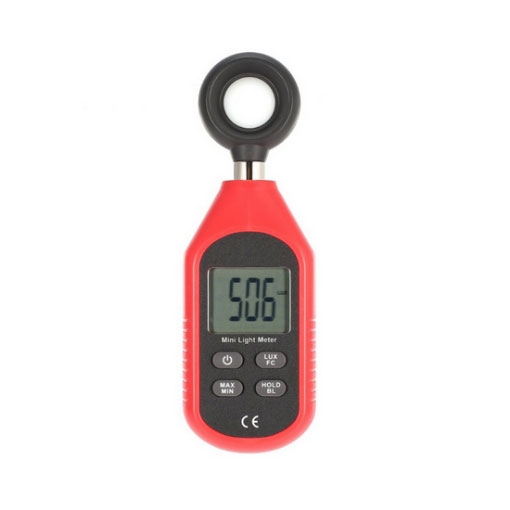Lux meter is a widely used instrument in the field of light intensity measurement, its main function is to measure the light intensity on a specific area or surface, thus helping people to better understand and manage the distribution and intensity of light. With the continuous development of science and technology, the lux meter plays an important role in many fields, such as architectural design, lighting engineering, indoor comfort assessment, plant growth research, etc.
The unit of illumination is to LUX, with the value of these places to express the appropriate intensity of light to ensure that adapt to a variety of environments daily life, offices, factories, and other environments have their own "suitable illumination". Once the illumination is insufficient or too high, it will be misidentified, operational inefficiency, fatigue, etc., leading to reduced vision, etc. When the illumination is moderate, it can improve work efficiency and ensure operational safety, so it is very important to pay attention to lighting management.
Principle of Operation
The working principle of the lux meter is based on the relationship between luminous flux and surface area. Luminous flux is the total optical power emitted by the light source, usually expressed in lumens. Surface area is the area of the area illuminated by light, usually expressed in square meters. Light intensity is the luminous flux through a unit area of the amount of light, usually expressed in LUX as a unit.
Lux meters utilize a photosensitive element, such as a silicon photocell or photodiode, to capture light and convert it into an electrical signal. The stronger the light, the greater the electrical signal produced. The lux meter measures the size of this electrical signal and converts it to a corresponding light intensity value in lux. Thus, the lux meter converts light energy into electrical energy, which is then calibrated to convert the electrical energy into light intensity.

Types
- Digital Lux Meters: A digital lux meters use a digital display to show the light intensity value. The digital lux meters are generally more accurate and reliable and can be switched between various units such as lux, foot-candles, etc.
- Analog Lux Meters: Analog lux meters use a pointer or scale to display light intensity, similar to a traditional meter. Although somewhat outdated in the digital age, analog lux meters are still useful in some situations.
- Portable Lux Meter: The portable lux meters are small and lightweight, and a good portable lux meter is useful for situations where you need to move around a lot or measure light intensity in different locations, such as for interior designers or photographers.
- Photo Lux Meters: Photo lux meters measure light intensity using a photodiode or other light-sensitive element. Photo lux meters are used in a wide range of applications such as photography, mapping, laboratory research, and more.
Areas of Application
Architecture and Interior Design: Designers and engineers can use lux meters to measure the light intensity in different areas to optimize lighting solutions. For example, in interior design, proper illumination distribution can enhance the brightness and comfort of an interior space while saving energy. Outdoors, and lux meters can help determine the light intensity in public areas, roads, and sidewalks to ensure adequate visibility and safety. In building design, lux meters can help determine the distribution of light in a room, ensuring proper lighting conditions for comfort and energy efficiency.
Industrial: On production lines, by regularly checking light intensity with a lux meter, maintenance personnel can identify and solve problems in time, ensuring that the lighting system is always working efficiently and consistently. Illumination meters can be used to ensure that work areas are properly illuminated to improve efficiency and safety.
Agriculture: In agriculture, using lux, researchers can measure light levels at different locations and heights to better understand how plants grow under different environmental conditions. This helps optimize the layout of greenhouses and outdoor plantings and helps farmers determine the best light conditions for plant growth, maximizing crop yield and quality.
Research and Laboratory: Researchers can use lux meters to measure light intensity under different experimental conditions to study the behavior and properties of light.
Medical and Healthcare: Illumination levels are closely related to a person's biorhythms, mood, and quality of sleep. Suitable lighting conditions can help adjust the biological clock in the human body, promoting physical health and good mental state. Lux meter monitoring in hospitals, nursing homes, and home environments ensures that patients and residents receive the right amount of light, thus improving their quality of life and state of health.
Lighting Industry: Lux meters play a key role in lighting projects, ensuring that the lighting in different places meets the appropriate standards and requirements.
Future Trends
- Intelligence and Automation: More intelligent lux meters are likely to emerge, capable of automatically adjusting light intensity and optimizing it for the environment and needs.
- Wireless Connectivity and Remote Monitoring: Lux meters may be connected to other devices for data transmission and monitoring via the Internet, enabling remote adjustment and management.
- Wider Applications: With the increasing awareness of the light environment, lux meter may be applied in more fields, such as healthcare and transportation.
- Higher Precision and Sensitivity: With the development of sensor technology, the lux meter may become more precise and sensitive, able to measure a wider range of light intensity.
The lux meter plays an important role in several fields as a key tool for measuring light intensity. It works on the principle of measuring light intensity by converting light energy into electrical energy based on the interaction of luminous flux, surface area, and photosensitive elements. In the future, with the continuous development of technology, lux meter may become smarter and more multi-functional, and play a role in more fields to promote a deeper understanding and application of the light environment. sisco shop offers a wide range of lux meters to choose from, if you are interested, please click to shop.

